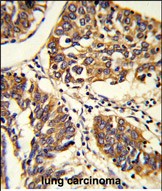PABPC1 Antibody (Center)
Purified Rabbit Polyclonal Antibody (Pab)
- 产品详情
- 文献引用 : 1
- 实验流程
- 背景知识
Application
| WB, IHC-P, E |
|---|---|
| Primary Accession | P11940 |
| Other Accession | Q6IP09, P20965, Q9EPH8, P29341, P61286 |
| Reactivity | Human, Mouse |
| Predicted | Bovine, Rat, Xenopus |
| Host | Rabbit |
| Clonality | Polyclonal |
| Isotype | Rabbit IgG |
| Calculated MW | 70671 Da |
| Antigen Region | 250-279 aa |
| Gene ID | 26986 |
|---|---|
| Other Names | Polyadenylate-binding protein 1, PABP-1, Poly(A)-binding protein 1, PABPC1, PAB1, PABP1, PABPC2 |
| Target/Specificity | This PABPC1 antibody is generated from rabbits immunized with a KLH conjugated synthetic peptide between 250-279 amino acids from the Central region of human PABPC1. |
| Dilution | WB~~1:1000 IHC-P~~1:100~500 E~~Use at an assay dependent concentration. |
| Format | Purified polyclonal antibody supplied in PBS with 0.09% (W/V) sodium azide. This antibody is prepared by Saturated Ammonium Sulfate (SAS) precipitation followed by dialysis against PBS. |
| Storage | Maintain refrigerated at 2-8°C for up to 2 weeks. For long term storage store at -20°C in small aliquots to prevent freeze-thaw cycles. |
| Precautions | PABPC1 Antibody (Center) is for research use only and not for use in diagnostic or therapeutic procedures. |
| Name | PABPC1 (HGNC:8554) |
|---|---|
| Function | Binds the poly(A) tail of mRNA, including that of its own transcript, and regulates processes of mRNA metabolism such as pre-mRNA splicing and mRNA stability (PubMed:11051545, PubMed:17212783, PubMed:25480299). Its function in translational initiation regulation can either be enhanced by PAIP1 or repressed by PAIP2 (PubMed:11051545, PubMed:20573744). Can probably bind to cytoplasmic RNA sequences other than poly(A) in vivo. Binds to N6-methyladenosine (m6A)-containing mRNAs and contributes to MYC stability by binding to m6A-containing MYC mRNAs (PubMed:32245947). Involved in translationally coupled mRNA turnover (PubMed:11051545). Implicated with other RNA-binding proteins in the cytoplasmic deadenylation/translational and decay interplay of the FOS mRNA mediated by the major coding-region determinant of instability (mCRD) domain (PubMed:11051545). Involved in regulation of nonsense-mediated decay (NMD) of mRNAs containing premature stop codons; for the recognition of premature termination codons (PTC) and initiation of NMD a competitive interaction between UPF1 and PABPC1 with the ribosome-bound release factors is proposed (PubMed:18447585). By binding to long poly(A) tails, may protect them from uridylation by ZCCHC6/ZCCHC11 and hence contribute to mRNA stability (PubMed:25480299). |
| Cellular Location | Cytoplasm. Cytoplasm, Stress granule. Nucleus. Cell projection, lamellipodium. Note=Localized in cytoplasmic mRNP granules containing untranslated mRNAs (PubMed:17289661). Shuttles between the cytoplasm and the nucleus (PubMed:9582337). During stress and in the absence of DDX3X, localizes to the nucleus (PubMed:21883093). At the leading edge of migrating fibroblasts, colocalizes with DDX3X (PubMed:28733330). Relocalizes to cytoplasmic stress granules upon cellular stress where it colocalizes with ENDOV (PubMed:27573237). In case of HRSV infection, localizes in cytoplasmic inclusion bodies substructures called inclusion bodies associated granules (IBAGs) (PubMed:31649314) |
| Tissue Location | Ubiquitous. |
For Research Use Only. Not For Use In Diagnostic Procedures.

Provided below are standard protocols that you may find useful for product applications.
BACKGROUND
PABPC1 binds the poly(A) tail of mRNA. It may be involved in cytoplasmic regulatory processes of mRNA metabolism such as pre-mRNA splicing. Its function in translational initiation regulation can either be enhanced by PAIP1 or repressed by PAIP2. PABPC1 can probably bind to cytoplasmic RNA sequences other than poly(A) in vivo. It may be involved in translationally coupled mRNA turnover. Implicated with other RNA-binding proteins in the cytoplasmic deadenylation/translational and decay interplay of the FOS mRNA mediated by the major coding-region determinant of instability (mCRD) domain.
REFERENCES
Le Clerc,S., et.al., J. Infect. Dis. 200 (8), 1194-1201 (2009)
终于等到您。ABCEPTA(百远生物)抗体产品。
点击下方“我要评价 ”按钮提交您的反馈信息,您的反馈和评价是我们最宝贵的财富之一,
我们将在1-3个工作日内处理您的反馈信息。
如有疑问,联系:0512-88856768 tech-china@abcepta.com.






















 癌症的基本特征包括细胞增殖、血管生成、迁移、凋亡逃避机制和细胞永生等。找到癌症发生过程中这些通路的关键标记物和对应的抗体用于检测至关重要。
癌症的基本特征包括细胞增殖、血管生成、迁移、凋亡逃避机制和细胞永生等。找到癌症发生过程中这些通路的关键标记物和对应的抗体用于检测至关重要。 为您推荐一个泛素化位点预测神器——泛素化分析工具,可以为您的蛋白的泛素化位点作出预测和评分。
为您推荐一个泛素化位点预测神器——泛素化分析工具,可以为您的蛋白的泛素化位点作出预测和评分。 细胞自噬受体图形绘图工具为你的蛋白的细胞受体结合位点作出预测和评分,识别结合到自噬通路中的蛋白是非常重要的,便于让我们理解自噬在正常生理、病理过程中的作用,如发育、细胞分化、神经退化性疾病、压力条件下、感染和癌症。
细胞自噬受体图形绘图工具为你的蛋白的细胞受体结合位点作出预测和评分,识别结合到自噬通路中的蛋白是非常重要的,便于让我们理解自噬在正常生理、病理过程中的作用,如发育、细胞分化、神经退化性疾病、压力条件下、感染和癌症。







